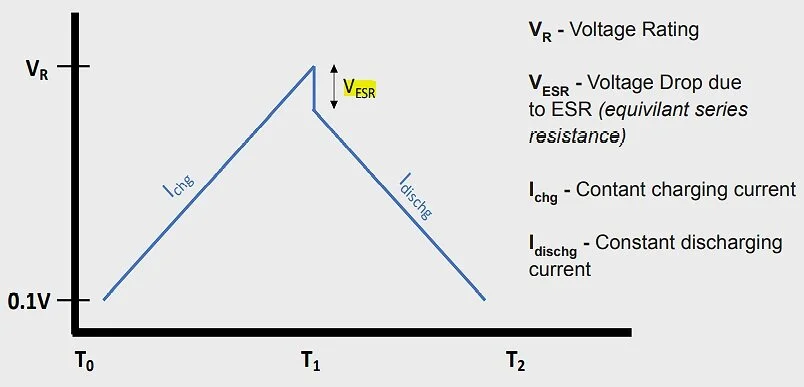Reading Flexible Supercapacitor Datasheets (and why it matters)
Capacitech Energy, Inc was founded to commercialize technologies that enable the future we want to live in. Alongside the University of Central Florida, we developed novel supercapacitor technology built like no supercapacitor before it to optimize designs and unlock performance.
Supercapacitors are a very exciting technology: capable of charging quickly, providing bursts of power, and surviving hundreds of thousands of cycles. Capacitech produces a wire-like and flexible supercapacitor called the Cable-Based Capacitor (CBC). This flexibility gives engineers new design opportunities through a placement advantage that helps them overcome the tradeoffs they typically face. Imagine a future where supercapacitors (energy storage components) are hidden; out of sight and out of mind.
The future is better with flexible supercapacitors. One of the first steps to building that future is helping researchers and engineers understand the CBC and design it into their products. This article is written as an introduction to the CBC’s datasheet.
Introduction to Datasheets:
Datasheets are instruction manuals provided by manufacturers for electronic components to explain what their product does and how to use it correctly. They may seem lengthy and complicated at first, but contain crucial information necessary for proper use and design that mitigate mistakes and risks. The material you will find in a datasheet will contain details such as, but not limited to:
o Typical device performance specifications
o Absolute minimum/maximum requirements and properties
o Testing without compromising the device
o Proposed uses
For the CBC, like other supercapacitors, the pertinent information is voltage rating, capacitance rating, equivalent series resistance (ESR), leakage current, energy storage capacity, peak power capability, and cycle life.
Voltage Rating:
This is the highest voltage that can be continuously applied to the supercapacitor, without failure and/or damage. The voltage rating is determined by the materials used inside the supercapacitor. Exceeding the voltage rating can damage the CBC’s performance, reduce its operating life, or damage its enclosure leading to a leak.
Capacitance Rating:
Capacitance refers to a supercapacitor’s ability to store energy in the form of an electrical charge. Capacitance indicates how much energy the CBC can store and is measured in the unit known as the Farad. The capacitance, energy storage capacity, and other important characteristics of the CBC can be determined by a Galvanostatic Charge/Discharge (GCD) curve. A GCD curve is produced by charging and discharging the CBC with constant current, as shown in the figure.
Capacitance can then be calculated using the results of the GCD curve and the formula i = C dv/dt , which represents the current being equal to the relationship of capacitance and the ratio of change over voltage and change over time.
Equivalent Series Resistance:
Equivalent Series Resistance (ESR) is the internal resistance of a supercapacitor measured in ohms. Its value is inversely proportional to a supercapacitor’s peak power capability. ESR is calculated by analysis of the GCD curve used to calculate capacitance by measuring the instantaneous voltage drop seen when the supercapacitor switches to its discharging cycle.
Leakage Current:
No supercapacitor is ideal. For this reason, when supercapacitors are modeled for real world analysis, two resistors are included: one is in series with the supercapacitor to represent ESR and the other is in parallel with the supercapacitor to represent leakage current. Leakage current can be thought of as the current required to keep the supercapacitor charged. To determine leakage current of a supercapacitor, connect a supercapacitor to a power supply and monitor the current draw over time (at least a few hours), this is the current required to keep the supercapacitor charged representing the leakage current.
Energy:
The CBC is a supercapacitor, which is an energy storage component at its core. The energy storage capacity of a supercapacitor is calculated by E = 1/2 C V^2 (measured in Joules), proportional to a supercapacitor’s capacitance and the voltage it is charged to (not to exceed its voltage rating). As capacitance and voltage increase, so does the energy storage. This formula can also be used for supercapacitor modules, where supercapacitor cells are connected in series and/or parallel. Supercapacitors are known to have a low energy density, meaning they do not store a lot of energy per unit mass compared to alternatives like batteries and fuel cells. Supercapacitors are not generally used for long-term energy storage needs. U_density = E_max / mass (measured in watt-hours per kilogram).
Power:
Supercapacitors like the CBC are designed for short burst, high-power applications given their high power density. Supercapacitors are designed to respond to sudden fluctuations in power. A supercapacitor’s peak power capability is largely depended on ESR. P_Density = [0.12 * V^2] / [ESR_DC * mass] (measured in watts per kilogram).
Cycle Life:
Although there is a belief that supercapacitors are capable of near infinite cycles in a life, they do have a limit. This idea came from the comparison to batteries, to which supercapacitors are vastly superior in regards to cycle life. The cycle life is the number of times the CBC may be charged and discharged, completing one cycle. To determine cycle life, the CBC is charged to the voltage rating of 1.6V at the current rating of 1.25A and discharge to 0.1V at 1.25A, completing one cycle. The process is repeated again and again until end of life (EOL) capacitance and ESR values are recorded.


